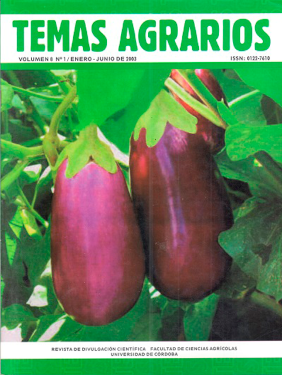Bromatological characterization of eggplant (Solanum melongena L.) in the state of Córdoba
Caracterización bromatologíca de la berenjena (Solanum melongenaL.) en el Departamento de Córdoba

This work is licensed under a Creative Commons Attribution-NonCommercial 4.0 International License.
Show authors biography
The bromatologic composition of 8 selected eggplant lines (L006, L007, L008, L012, L014, L015, L016, L019), was evaluated based on humidity, ashes, total protein, ethereal extract and crude fiber using the methods of the A.O.A.C. 930, 15/90, 942. 05/90, 955. 04/90, 920. 39/90 and 962. 09/90, respectively. The total carbohydrates were calculated by the difference between the 100% and all other components but fiber. Within ashes calcium, sodium, phosphor, iron, and potassium were quantified. Potassium showed the highest quantity with a mean of 206,21 mg, calcium and sodium also showed high proportion levels with means of 68, 62 and 58,22 mg, respectively. Iron and phosphorus showed low levels in all genotypes but in line L014 with values above 15 mg. The genotypes with higher nutritious values are L016, L007, L012, L014 y L016 which, together with their desirable characteristics are the ones with potential for commercial exploitation in the national market.
Article visits 2339 | PDF visits
Downloads
- Alonso, J. 2004. La importancia de las fibras vegetales en la salud humana. http://www.plantasmedicinales.org/ trabrep/ may2000/trabep6.htm [Accedido 03-14-2005]
- Ballesteros, M.; Cabrera, M.; Saucedo, M. y Grijalva, M. 1998. Consumo de fibra dietética, sodio, potasio y calcio y su relación con la presión arterial en hombres normotensos. Salud Pública de México 40(3): 241-245
- Bernal, I. 1993. Análisis de los Alimentos. Guadalupe Ltda. Santa fe de Bogotá. D.C., p.180 C.R.I.G.P. 2004. Consejo Regulador de la indicación Geográfica Protegida. http:/
- /www.berenjenas.castillalamancha.es/ Proyectos.htm. [Accedido 22/10/2004]
- Ciudad Futura 2003. Verduras y Hortalizas que curan. http:// www. Ciudadfutura.com/ remediosnaturales/berenjena2.htm. [Accedido 02/10/2003]
- COMFENALCO Antioquia. 2003. Revista salud en buenas manos. http: //www comfenalcoantioquia.com/ http:// www.consumer.es/neb/es/nutriciòn. [Accedio 02/12/2003]
- Figueroa, W. 2004. Como reducir el consumo de sodio sal, sodio y presión arterial. http://www.saludnutricion.com/scripts/ salud.dll [Accedido 10-22-2004]
- García, E. y Hoyos, F. 1999. Estimación de la variabilidad genética en una población criolla de berenjena (Solanum melongena L.) en el Departamento de Córdoba Tesis Ingeniero Agrónomo, Universidad de Córdoba, Montería, p.66
- Gebhart, S. y Matthews, R. 1988. Nutritive value of food USDA-HINS. Home and Garden Bull, Washington D.C., p.320
- Mangione, J. y Sánchez, G. 1999. Cultivo y manejo poscosecha de berenjena. Corporación Mercado Central de Buenos Aires. http:// www.mercadocentral.com.ar/ site2001/técnicas/berenjena zip. [Accedido 10-30-1999]
- Rifran, N. 2004. Nutrientes esenciales. http:/ /www.monografías.com/trabajos 3/ nutries/nitries.html [Accedido, 9-15- 2003]
- SADECOR. 1998. Producción de Frutas y Hortalizas Semestre A de 1998. UMATA, Secretaría de Agricultura Seccional Córdoba, Montería.
- Saludholística. 2003. http://www.salud/ holistica.com/bellezaysalud/ seasadoble.html. [Accedido 02-12- 2003]
- Tolonen, M. 1995. Vitaminas y Minerales en la salud y nutrición. Acribia, Zaragoza, p.250




















